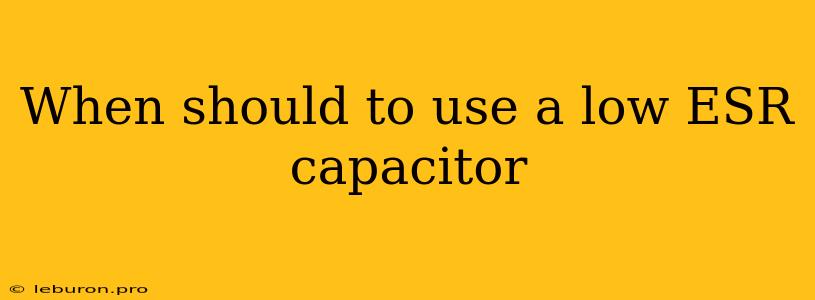Capacitors are ubiquitous components in electronic circuits, playing a crucial role in filtering, energy storage, and timing applications. Within the diverse world of capacitors, low ESR capacitors stand out as specialized components designed for high-frequency applications and scenarios where minimal energy dissipation is critical. But when exactly should you opt for a low ESR capacitor over its higher ESR counterparts? This article delves into the nuances of ESR and its impact on circuit performance, equipping you with the knowledge to confidently select the right capacitor for your needs.
Understanding ESR: The Essence of Capacitor Performance
ESR, short for Equivalent Series Resistance, represents the inherent resistance within a capacitor. It's a crucial parameter that dictates how effectively a capacitor can store and release energy, influencing its performance in various applications.
High ESR capacitors exhibit significant internal resistance, leading to energy dissipation as heat. This dissipation becomes particularly detrimental at high frequencies, where the capacitor experiences rapid charge and discharge cycles. Consequently, high ESR capacitors are unsuitable for high-frequency applications, such as power supply filtering or switching circuits.
Low ESR capacitors, on the other hand, possess minimal internal resistance, minimizing energy loss. This characteristic makes them ideal for scenarios where high-frequency performance and energy efficiency are paramount.
When to Choose Low ESR Capacitors: A Comprehensive Guide
The decision to employ a low ESR capacitor hinges on the specific demands of your circuit. Here's a breakdown of key considerations that guide your choice:
1. High-Frequency Applications: The Domain of Low ESR
High-frequency circuits are characterized by rapid changes in voltage and current, demanding capacitors that can respond quickly and efficiently. Low ESR capacitors excel in these applications, offering the following advantages:
- Minimized Ripple Voltage: In power supply circuits, low ESR capacitors effectively filter out high-frequency noise, reducing ripple voltage and ensuring stable power delivery. This is crucial for sensitive electronic devices that require clean power.
- Enhanced Switching Efficiency: In switching regulators and inverters, low ESR capacitors enable fast charge and discharge cycles, leading to improved efficiency. This translates to less energy loss as heat, maximizing overall performance.
- Improved Signal Integrity: In high-speed digital circuits, low ESR capacitors minimize signal distortion caused by impedance mismatches, ensuring accurate data transmission.
Examples:
- Power Supply Filtering: Smoothing out voltage fluctuations in power supplies for sensitive electronics.
- Switching Regulators: Efficiently storing and releasing energy in DC-DC converters.
- High-Speed Digital Circuits: Preserving signal integrity in fast-paced digital communication systems.
2. Power Dissipation: Minimizing Energy Loss
Low ESR capacitors are critical in applications where minimizing energy loss is paramount. By reducing the internal resistance, they minimize the conversion of electrical energy into heat, improving efficiency and system stability.
Examples:
- Battery-Powered Devices: Maximizing battery life and minimizing heat generation in portable electronics.
- High-Power Audio Amplifiers: Ensuring efficient operation and minimizing distortion caused by excessive heat.
- Industrial Automation: Optimizing energy utilization in demanding industrial applications.
3. Thermal Considerations: Avoiding Overheating
High ESR capacitors generate substantial heat during operation, potentially leading to component damage or system instability. Low ESR capacitors, with their minimal internal resistance, generate significantly less heat, ensuring safe and reliable operation.
Examples:
- High-Density Electronics: Preventing overheating in compact devices with limited ventilation.
- Automotive Applications: Withstanding high temperatures and harsh environments.
- Medical Devices: Ensuring safe and reliable operation in sensitive medical applications.
4. Pulse Applications: Delivering Energy on Demand
Low ESR capacitors are adept at handling fast, high-current pulses, delivering energy efficiently in short bursts. This makes them ideal for pulsed power applications.
Examples:
- Laser Drivers: Providing high-energy pulses to power lasers.
- Flash Photography: Delivering a large amount of energy for a short duration to illuminate the subject.
- Pulse Generators: Creating precisely timed pulses for various applications.
Navigating the ESR Spectrum: Choosing the Right Capacitor
While low ESR capacitors are advantageous in many scenarios, it's important to recognize that they are not always the ideal choice. Factors like cost, size, and operating voltage must also be considered.
- Cost: Low ESR capacitors generally come at a premium compared to their higher ESR counterparts.
- Size: They often have larger footprints due to the specialized construction required for low ESR.
- Operating Voltage: Low ESR capacitors may have lower voltage ratings compared to standard capacitors.
When selecting a capacitor, carefully weigh the specific requirements of your application. If high-frequency performance, minimal energy loss, and thermal stability are paramount, low ESR capacitors are the right choice. However, if budget constraints, space limitations, or operating voltage constraints are significant factors, a careful evaluation of all parameters is necessary to select the most suitable capacitor.
Conclusion
Low ESR capacitors play a crucial role in optimizing performance, efficiency, and reliability in a wide range of electronic circuits. Their ability to handle high frequencies, minimize energy dissipation, and withstand thermal stresses makes them invaluable for modern electronic design. When confronted with high-frequency applications, demanding power requirements, or thermally sensitive environments, consider utilizing low ESR capacitors to elevate your circuit's performance and achieve optimal results.
